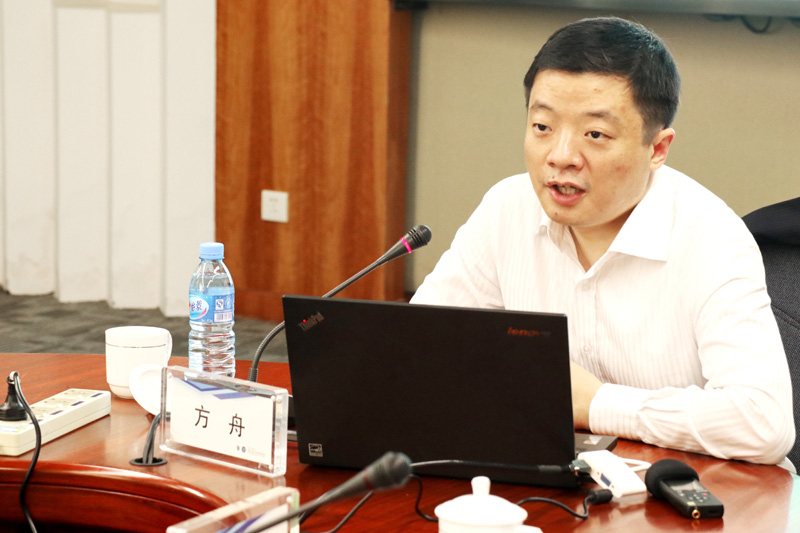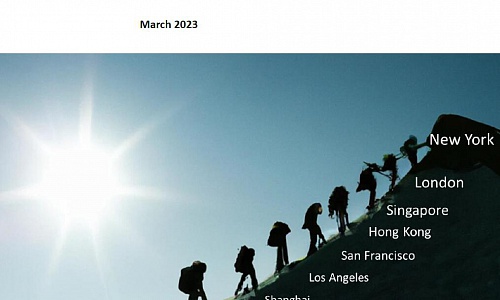Collaboration in Guangdong-Hong Kong-Macao Greater Bay Area
 Author: Fan Gang, President of CDI
Author: Fan Gang, President of CDI
Editor’s Note: The Guangdong-Hong Kong-Macao Greater Bay Area hinges on the concept of metropolitan area and the coordination of different mechanisms. The establishment of the “2+3” free trade area consisting of Nansha, Qianhai, Hengqin, Hong Kong and Macao will promote the development of the Bay Area.
Metropolitan areas provide impetus for China’s urbanization, industrialization and innovation-driven growth since they have emerged as a solution to urban challenges like housing, traffic and employment. The Guangdong-Hong Kong-Macao Greater Bay Area will be a major driving force for China’s development.
There is a great chance to establish a free trade zone alliance inside the Bay Area while Hong Kong and Macao tariff-free zones are already in the region. In addition, Guangdong has three pilot free trade zones, Nansha, Qianhai and Hengqin. It will be an innovative move to join Hong Kong, Macao, and the three free trade zones, to form the “2+3” free trade area. Once the alliance is established, the development of the free trade area will be facilitated so does the Greater Bay Area as a whole.
The Bay Area will continually unleash potential and upgrade economic structure, with an increasing share of the high-end service sector and emerging industries such as digital economy, life sciences, aerospace, renewable and sustainable energy, etc. It will become a global international trade center for goods and services.
Mobike Acquired: Sharing Economy Ends?
 Author: Cao Zhongxiong, Executive Director, New Economy Research Department
Author: Cao Zhongxiong, Executive Director, New Economy Research Department
Overview: Mobike’s acquisition and Didi Chuxing’s dilemma mark that the sharing economy is entering its difficult times. In the future, the mobile transportation platforms need to think about how to make profits; otherwise they are doomed to be merged.
The sharing economy can integrate all kinds of dispersed idle resources, solve the problem of asymmetric information, and accurately find diversified demands, so that the resources can be efficiently reallocated. However, concern about the prospect of the sharing economy has been exposed by the acquisition of Mobike and Didi Chuxing entering a difficult time.
Mobike’s acquisition and Didi Chuxing’s dilemma show that the sharing economy is faced with three difficulties: firstly, it starts with “free user charge” and might be ended by “free user charge”; secondly, it excessively pursues the user growth; thirdly, it only focuses on financing instead of making profits.
The mobile transportation platforms need to operate as an enterprise. Firstly, the sharing economy enterprise must be profitable. Secondly, the sharing economy needs to reduce its operating costs. Thirdly, the sharing economy needs to be regulated by authority when it involves with social benefits and consumer protection. As long as the mobile transportation platforms create sustainable revenue, the integration can be avoided.
China Shall Actively Respond to Sino-US Trade Frictions
 Author: Fan Gang, President of CDI
Author: Fan Gang, President of CDI
Editor’s Note: Impelled by the anxieties over China’s economic rise, United States has initiated a series of actions towards China, including the trade war and possibly with investment and intellectual property as targets. China shall actively respond to these actions with long-term development interests in mind.
The current trade frictions between China and the United States have not yet escalated to a trade war, although both sides are “preparing” for one. There are several issues that should be looked at properly.
With increasing anxiety over China’s economic rise and change in world economic landscape, United States now intends to contain China’s development by targeting intellectual property and imposing restrictions on high-tech exports in the name of “reducing trade deficits”.
Two issues need to be made clear regarding Sino-US trade imbalances.
First, before being assembled in China, 90% of parts are not produced in China, but are rather imported from other Asian countries as part of the production chain. In other words, much of China’s trade deficit will end up as trade surplus with the US.
Second, at certain points nearly 60% of exports are derived from multinational corporations in China. Some products were produced by American multinational corporations in China and exported to United States, in which case China’s profits were rather low. American consumers have benefited from high-quality and reasonably priced products made in China. The US has also enjoyed a relatively low inflation rate. The US government, however, has failed to properly examine this issue, only focused on the impact of China’s rise on the US instead.
Since China is part of the global production chain, in the long run the trade war will certainly have negative effects on China and the US as well as other countries that are part of the production chain.
China’s biggest interest is sustained development. As a late starter, China should be fully aware of the difficulties during development despite fast economic growth over the past 40 years. To maintain sustainable growth, China needs to keep long-term interests in mind and minimize external disturbances through rational counter measures.
Promoting BRI with Spirit of Reform and Opening Up
 Author: Hu Zheng, Invited Researcher of CDI, Director of China Merchants Group, and Chief Representative of China Merchants Group in Central Asian and Baltic Region
Author: Hu Zheng, Invited Researcher of CDI, Director of China Merchants Group, and Chief Representative of China Merchants Group in Central Asian and Baltic Region
Editor’s Note: The implementation of the Belt and Road Initiative (BRI) shall be closely combined with the reform and opening up, top-level design, shared development, sustainability. Construction of overseas industrial parks is the highlight of BRI. In the new era, the emphasis of BRI is to properly deal with the relationship between “Going Out” and “Bringing In”.
The implementation of BRI deepens China’s reform and opening up and they are closely integrated with each other. In the course of reform and opening up that started since 1978, the most prominent feature is “Bringing In”. The establishment of special economic zones, high-tech parks, bonded logistics parks, free trade zones and the introduction of capital and technology have directly driven the leapfrog development of China’s economy and have also exerted significant impact on the world.
Under the context of the reform and opening up and with the advancement of BRI, the “Going Out” is endowed with new characteristics. First is the support of national strategies and policies. Second, we should focus on addressing top-level design issues such as policy coordination, infrastructure connectivity, trade, currency and people. Third, we should uphold the concept of shared development. Fourth, we should aim at sustainable development. Chinese enterprises should innovate and create a new model of Going Out.
Construction of overseas industrial parks is the highlight of BRI and has gained high recognition from countries along BRI. The construction of parks will not only drive local economic development and promote local employability, but also facilitate the transformation and upgrading of production capacity. Overseas industrial parks have become the strategic pillar of BRI and provided Chinese enterprises with a new platform of win-win cooperation.
In the new era, the implementation of BRI should be promoted with the spirit of reform and opening up. In this process, we should adhere to the concept of win-win cooperation, properly handle the relationship between “Going Out” and “Bringing In”. That means China should export its own development experience and learn from others at the same time, which will greatly enrich the connotation of BRI. In addition, we should value sustainable development and share mutual benefits while implementing BRI.
Globalization Will Not Be Stopped by Trade War
 Author: Fan Gang, President of CDI
Author: Fan Gang, President of CDI
Editor’s Note: Eventually, China and the United States will need to sit down at the negotiating table to solve trade frictions.
Trump would sooner or later impose trade sanctions on China, but no one had expected such a big move. China’s exports to the United States amounts to over 400 billion U.S. dollars, while Trump is now seeking to impose tariffs on up to $60 billion of Chinese imports. Such a big move on trade shows that the United States treats China as its primary rival in trade. The action also illustrates that such superpower like United States can be brutal sometimes, adopting measures without any evidence or reasonable analysis and ignore rulings by the WTO.
American consumers will be the victims of trade war between the US and China. The trade war will also harm China as the consumer product prices could rise. It is necessary for China to consider the price elasticity of demand when deciding how much to export. Generally speaking, the trade war will impact on United States as much as China. There is the fear that if you want to fight this trade war and I do not fight back, you would probably be even less reasonable tomorrow. Thus, China will certainly take countermeasures.
Keep a level head in face of US-China trade war
As a rising middle-income country, China needs to be prepared for the possible suspicion, antagonism and even aversion from others. These reactions must be taken care of proactively but also with a cool head. This is not the first time for China to meet with oppositions from other countries, nor will it be the last. China shall keep a level head in face of the cacophony of voices as it rises.
Those who in the past believed the China’s growth depended on low-end manufacturing have now discovered that China is able to innovate and has even become a leader in certain high-tech industries. The western world now feels threatened as China becomes a stronger competitor. And the trade war is highly interconnected with the rise of rise since Trump has declared that the trade sanctions on China are to protect US interests.
China has worked hard for its own success. Chinese have lower per capita income but are increasingly capable of innovation. Most exporters in China are private companies not subsidized by the government. There are many foreign-funded products and services among Chinese exports as well, for example, products that are manufactured in China by American businesses, which also count as Chinese exports to the US when calculating the US trade deficit with China.
Structural conflicts exist in Sino-US trade
The Sino-US trade frictions is not simply caused by trade deficit but more fundamental structural challenges existing in the two kinds of economies. Initially, the US alleged that the deficit due to China’s low foreign exchange rate. However, trade deficit has persisted after China raised RMB’s exchange rate against the US dollar. Even after US conducted the 301 Investigation against China, trade deficit still stayed on the same level.
China is not only highly competitive in a wide range of industries and also benefits from low cost and high efficiency in many fields. Even though, the competitivity in high-tech industries still needs to improve. Structural problems exist in Sino-US trade in the sense that China is not allowed to import the desired products as it exports its products to the US.
Stand up to US-China trade war
First, China needs to have reciprocal countermeasures. China will probably raise tariffs in response to the imposed higher tariff, which is something that China is capable of doing. Second, crisis management consciousness is crucial to preventing potential risks from developing into full-fledged crises. China needs to negotiate and defuse tensions where possible to avoid a completely hostile situation. Third, China-US trade only accounts for just 16-17% percent of global trade, and trade with Europe, another 16-17%. China also has the option to develop trade relations with emerging countries, including countries in Latin America, Middle East and Africa.
China’s core concern is still development. China welcomes foreign investment not just for the sake of attracting capital, but also creating jobs and bringing in advanced technologies and management. We observe how foreign-funded businesses operate and learn their experience in management. This is not stealing, as this kind of knowledge or expertise is universally shared. It is a common practice among all countries to model on existing products and come up with similar products on their own, not just in China. China is committed to staying open and will not shut its door for foreign businesses even though its own businesses are denied entry into a foreign country.
Globalization will not stop
Globalization was started by American capital and multinationals in the first place. American workers did not take it seriously at the beginning, but globalization has indeed spurred the development of China. As farmers leave villages to work in cities, China has seen a steady increase in per capita income, fast development of technologies and larger exports. Naturally, discontent in the US rises as local workers lose jobs to their foreign counterparts. In a sense, reversals and relapses in the process of globalization are inevitable. It is therefore important to anticipate challenges and be prepared.
However, globalization will not stop. Multinationals from developed countries now continue to promote globalization as they are still establishing their presence across the world today to maximize their gains. Two new forces have also joined to promote globalization nowadays, one being low-income countries which have discovered the benefits of attracting foreign investments for their own development from the experience of China and India, the other being middle-income countries like China.
China, as a middle-income country, needs globalization in the process of bringing in foreign capital and encouraging its businesses to go global. Going global is a must for China in view of its domestic excess of capital. Despite a moderate level of income in China, the high savings rate has resulted in a huge amount of capital, which will lead to overcapacity if invested within the country. Many Chinese businesses have also come to realize the importance of seizing the opportunity to develop abroad as China restructures its economy, thus starting to allocate global resources.
Despite opposing voices, globalization will continue in the long run. It is natural that the US wants to get some of its businesses back to accommodate the interest of domestic workers, as all governments wish to see more investment within their own borders. While there are many reasonable ways to do this - reducing interest rate in particular - fighting a trade war, however, is a bit of reversal of globalization.
What Else Can Be Done for Anticancer Drugs Besides Zero Tariffs
 Author: Liu Muyun, Invited Researcher of CDI and President of Beike Biotechnology
Author: Liu Muyun, Invited Researcher of CDI and President of Beike Biotechnology
Editor’s Note: Zero tariffs alone cannot address the root cause of exorbitant prices of imported anticancer drugs and much more should be done to expand market access to quality anticancer drugs.
When he held a news conference at the end of the two sessions, Premier Li Keqiang said that tariffs on drugs will be slashed, while the much-needed anticancer drugs might phase in zero tariffs. However, zero tariffs alone cannot address the root cause of exorbitant prices of imported anticancer drugs.
It can achieve a scale effect for international pharmaceutical companies to concentrate the large market demand of China, negotiate directly with the producers via a national channel and purchase anticancer drugs in bulk. National procurement does not only mean lower prices, but also quality assurance. It is feasible to set up a centralized procurement platform at the national level with a new state administration on medical insurance to be put into place according to the State Council institutional reform plan of 2018.
We should give play to the role of Internet, establish an evaluation database for anticancer drugs, a catalogue of much-needed clinical drugs, a database to optimize catalogue and price negotiations of the centralized procurement.
In addition to scientific and technological innovation, mechanism innovation is also needed. We should reform the management of clinical tests, speed up the review and approval system for innovative drugs, accelerate application and marketization of research results, improve the business environment generic drugs, and combine technological innovation with clinical diagnosis and treatment.
The key role of medical service in the treatment of complicated diseases should also get enough attention. Innovative drugs, surgery and therapy are all clinical diagnosis and treatment tools; however, people who use these tools efficiently and economically also matters. Health practitioners deserve recognition and respect from the society.
Boost Science and Technology Innovation in Guangdong-Hong Kong-Macao Greater Bay Area
information

Venue: Room 101, CDI Mansion, Shenzhen
Host: CDI
Theme: Boost Science and Technology Innovation in Guangdong-Hong Kong-Macao Greater Bay Area
Exit from the Integrated World May Be Costly
 Chinese economic growth was stable in Q1. GDP was up 6.8% y/y, flat on Q4. Industrial output was up 6.8% y/y, and up 0.6 pps from Q4.
Chinese economic growth was stable in Q1. GDP was up 6.8% y/y, flat on Q4. Industrial output was up 6.8% y/y, and up 0.6 pps from Q4.
Investment rose 7.5% y/y in Q1, up 1.7 pps from the lowest growth rate of 2017. However, the price-adjusted investment growth rate rose only 1.2% y/y. Assuredly, private investment recovered strongly, and rose 8.9% y/y, up 4.7 pps from Q3, reaching its highest rate since 2016. In Q1, real estate investment grew 10.4% y/y, up 6.3 pps from Q4 - its highest growth rate since 2015.
Retail sales of consumption goods were up 9.8% y/y in Q1 in nominal terms, and 8.1% y/y in real terms. Although both figures were only slightly lower than in Q4, these were among lowest growth rates since 2004.
Prices are declining, amid tightening monetary policy. CPI was up 2.1% y/y in March, down 0.1 pps from January-February. In March, producer price growth continued to fall rapidly. The ex-factory price index of industrial output was up 3.1% y/y, down 0.6 pps from February. This is the fifth consecutive decline. PPI was up 3.7% y/y, down 0.7 pps from February. Monetary policy is still tightening, and financial regulation is stricter, intended to reduce financial risk. In March, M1 rose 7.1% y/y, down 4.7 pps from the end of 2017, and down 11.7 pps from last March.
Though exports were up 14.1% y/y in Q1, up 4.9 pps from Q4 and up 8.5 pps from Q3, and imports were up 18.9% y/y, China and the United States are in a trade war. On March 22nd, U.S. President Donald J. Trump signed a memorandum to apply tariffs of $50 billion on Chinese goods. In a quick response, China raised its tariffs on 128 U.S. products, with implementation beginning on April 2nd. Both countries indicated that they plan to hike tariffs on the other’s exports far more.
The U.S.-China trade war may be short-lived. We believe that the United States has more to lose. The exit of U.S. firms from the Chinese outsourcing labor market will give its competitors a greater advantage in improving their balance sheets, and consequently in profit, R&D expenditure and TFP -- and in the end, more wins. Take the U.S.’s Apple vs. South Korea’s Samsung, for example. China’s large state capacity, as seen from the state sector’s sizable share of the economy and better government budget situation, will make growth both feasible and stable, as greater state capacity means better macro management ability. Too, the share of exports in Chinese GDP growth has declined steadily over the years.
Growth Targeted at About 6.5%
 Prime Minister Keqiang Li announced during a March 5th address to the People’s Congress of Beijing that China’s growth target for 2018 would be about 6.5%, the same as in 2017, when growth reached 6.9%. The yuan will be “basically stable” at a reasonable level, Li also predicted. More local government debt will be cut, but not at the cost of infrastructure. Moreover, reducing financial risk will be key for the regulatory agency, an emphasis further confirmed by new Central Bank governor Gang Yi, who took office after Xiaochuan Zhou’s 13 years of service.
Prime Minister Keqiang Li announced during a March 5th address to the People’s Congress of Beijing that China’s growth target for 2018 would be about 6.5%, the same as in 2017, when growth reached 6.9%. The yuan will be “basically stable” at a reasonable level, Li also predicted. More local government debt will be cut, but not at the cost of infrastructure. Moreover, reducing financial risk will be key for the regulatory agency, an emphasis further confirmed by new Central Bank governor Gang Yi, who took office after Xiaochuan Zhou’s 13 years of service.
Only three days after the People’s Congress ended, U.S. President Donald Trump announced the plan to impose tariffs on $60 billion China’s exports to the United States. Such unilateral protectionist measures really pushed the Chinese economy, China-U.S. economic relations and the whole global trade system into great uncertainty, at least for the near future! Exports in January-February were up 24.4% y/y, a significant 15.2 pps rise from Q4 2017. Though export growth is generally rising, the current surge is still exceptional, and likely to be a short-term phenomenon. Imports were up 21.7% y/y, and the adjusted growth rate a still-flat rise of about 14.7% y/y.
Industrial output was up 7.2% y/y in January-February, up 1.1 pps from Q4, to a new post-2015 high. Fixed asset investment was up 7.9% y/y, up 1.5 pps from Q4, and up 2.1 pps from its nadir in Q3. Retail sales of consumer goods were up 9.7% y/y in nominal terms, down 0.2 pps from Q4, and up 7.9% y/y after considering the price factor, and down 0.5 pps from Q4. In February, the ex-factory price index of industrial products was up 3.7% y/y, a constantly falling growth rate, down 2.2 pps from Q4. PPI has demonstrated a similar trend. We expect producer price growth to fall further, given tightening monetary policy. CPI continued its slower rise, up 2.2% y/y in January-February, and up 0.4 pps from Q4. We expect CPI to rise by around 2.5% this year. M1 was up 11.7% y/y, and the adjusted rate is around 10% y/y, still falling from August 2016. M2 was up 8.7% y/y, less than almost every month in 2017.
Chinese politics has received much media attention this month. The first issue was the constitutional change of presidential term limits, with the elimination the two-term limit making it possible for President Jinping Xi to remain in his post after his second term. The second issue was the creation of new top positions and agencies, such as the National Supervision Commission, at the same political rank as the Justice Department, to battle corruption. We see policy continuity from this change of political arrangement, with deepening reform. We view centralization as favorable for breaking regional and uncoordinated barriers, such as pollution. And the continuing anti-corruption campaign will benefit the economy. At least for the short and medium term, we view China’s political arrangement as favorable to its growth.
Success Story of SEZs in China Helps Industrial Park in Coate d’Ivoire
 On March 12, CDI held China-Africa Special Economic Zones Seminar in Coate d’Ivoire with representatives from Ministry of Industry and Mines of Coate d’Ivoire, African Export-Import Bank, Agency of Management and Development of Industrial Infrastructure (AGEDI) and Funds of Development of Industrial Infrastructure (FODI), Made in Africa Initiative, and Chinese enterprises in Coate d’Ivoire attending. CDI experts gave presentations about development experience of Chinese special economic zones and made suggestions for industrialization of Africa and strategies of industrial zones in Coate d’Ivoire.
On March 12, CDI held China-Africa Special Economic Zones Seminar in Coate d’Ivoire with representatives from Ministry of Industry and Mines of Coate d’Ivoire, African Export-Import Bank, Agency of Management and Development of Industrial Infrastructure (AGEDI) and Funds of Development of Industrial Infrastructure (FODI), Made in Africa Initiative, and Chinese enterprises in Coate d’Ivoire attending. CDI experts gave presentations about development experience of Chinese special economic zones and made suggestions for industrialization of Africa and strategies of industrial zones in Coate d’Ivoire.










